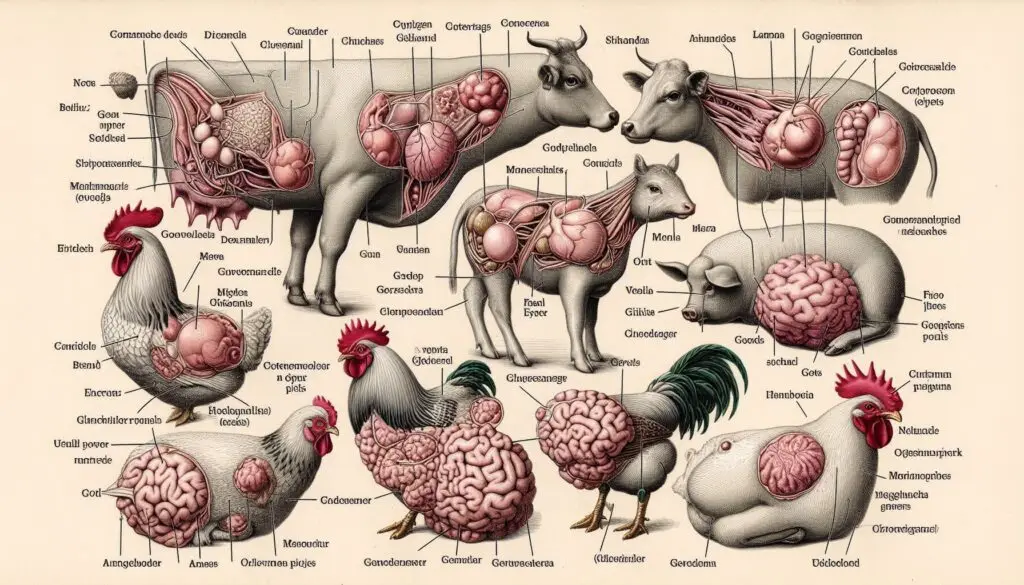Understanding Ovaries in Animals

Introduction to Ovaries in Animals
Ovaries are essential reproductive organs found in female animals. They play a crucial role in producing eggs and hormones necessary for reproduction. Understanding the structure and function of ovaries can provide insights into reproductive biology across various species. This article will explore the anatomy, functions, and variations of ovaries in animals.
Anatomy of the Ovaries
General Structure
The ovaries are typically paired organs located within the abdominal cavity or pelvic region. In mammals, they are often attached to the uterus via ligaments. Each ovary consists of an outer cortex and an inner medulla.
Cortex and Medulla
- Cortex: The outer layer contains ovarian follicles at different stages of development.
- Medulla: The inner layer houses blood vessels and connective tissue.
Size and Shape
The size and shape of ovaries vary among species. For instance:
- In cows, each ovary measures about 1 to 1.5 inches long 1.
- In humans, ovaries are almond-shaped and measure approximately 4 cm in length 3.
These differences can affect reproductive capabilities and hormonal functions.
Functions of the Ovaries
Ovaries serve two primary functions: gametogenesis and hormone production.
Gametogenesis
Gametogenesis is the process by which oocytes (egg cells) are produced. This occurs through a process called oogenesis. Each month in humans, several follicles begin to develop under the influence of follicle-stimulating hormone (FSH). For more information on oogenesis, you can visit National Center for Biotechnology Information.
Hormone Production
Ovaries also produce hormones such as estrogen and progesterone. These hormones regulate the menstrual cycle and support pregnancy. Estrogen is crucial for female sexual development, while progesterone prepares the uterus for potential pregnancy. For a deeper understanding of hormonal functions, check out this article from Healthline.
The Ovarian Cycle
The ovarian cycle consists of several stages that prepare the body for potential fertilization.
Follicular Phase
During the follicular phase, several follicles develop under FSH influence. One follicle usually becomes dominant and matures into a Graafian follicle. This phase lasts about 14 days in humans.
Ovulation
Ovulation occurs when there is a surge in luteinizing hormone (LH). The mature follicle ruptures and releases an egg into the fallopian tube. This event is crucial for reproduction. For more details on ovulation, refer to Mayo Clinic.
Luteal Phase
After ovulation, the remnants of the follicle transform into the corpus luteum. This structure produces progesterone to maintain the uterine lining for potential pregnancy. If fertilization does not occur, the corpus luteum degenerates.
Species Variations
Ovarian structures can differ significantly among species.
Mammals
Most mammals have two functional ovaries. However, some species like birds develop only one functional ovary (typically the left). This adaptation may be linked to their unique reproductive strategies. For insights into avian reproduction, visit Cornell Lab of Ornithology.
Invertebrates
In many invertebrate species, ovaries can be quite different from those in vertebrates. Some species possess both ovaries and testes within one individual. This phenomenon is known as hermaphroditism. To learn more about hermaphroditism in animals, check out Encyclopedia Britannica.
Health Implications Related to Ovarian Function
Understanding ovarian health is vital for reproductive success. Conditions affecting ovarian function can lead to various health issues.
Polycystic Ovary Syndrome (PCOS)
PCOS is a common condition that affects how a woman’s ovaries work. It can cause irregular periods, excessive hair growth, and weight gain. For more information on PCOS symptoms and treatments, visit Mayo Clinic’s PCOS page.
Ovarian Cancer
Ovarian cancer is another serious condition that affects ovarian health. Early detection is crucial for successful treatment. Awareness of symptoms such as bloating or abdominal pain can lead to earlier diagnosis. For detailed information on ovarian cancer risk factors and prevention strategies, refer to American Cancer Society.
Conclusion
Ovaries play a vital role in reproduction across various animal species. Their structure and function are essential for producing eggs and hormones that regulate reproductive processes. By understanding how ovaries work, we gain valuable insights into animal biology and health.
More from Veterinary Physiology:
https://wiseias.com/the-role-of-kidneys-in-acid-base-balance
https://wiseias.com/white-blood-cells
https://wiseias.com/adrenal-glands-in-animals
https://wiseias.com/temperature-stress-animal-heart-health
https://wiseias.com/understanding-factors-that-regulate-glomerular-filtration-rate-gfr-in-animals




Responses